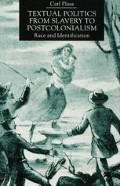Abstract
For Madhu Dubey, the critical context most germane to a reading of Toni Morrison’s The Bluest Eye (1970) is that of the Black Aesthetic movement which came to prominence in the America of the 1960s and early 1970s and was ‘explicitly developed as the literary arm of black cultural nationalism’.2 Yet, as Dubey points out, Morrison’s fictional practice in The Bluest Eye — like that of other African American women writers of the time — is one that significantly exceeds the prescriptions of Black Aesthetic theory: the novel not only engages in an exploration of black female subjectivity which Black Aestheticians sought to discourage, but also emphasizes ‘the sexual division between black men and women that can potentially disrupt the racial unity projected in black nationalist discourse’.3
Of all the wishes people had brought him — money, love, revenge — this seemed to him the most poignant and the one most deserving of fulfillment. A little black girl who wanted to rise up out of the pit of her blackness and see the world with blue eyes.
Toni Morrison
We who come from the Antilles know one thing only too well: Blue eyes, the people say, frighten the Negro.
Frantz Fanon1
Access this chapter
Tax calculation will be finalised at checkout
Purchases are for personal use only
Preview
Unable to display preview. Download preview PDF.
Notes
The epigraphs to this chapter are taken from Toni Morrison, The Bluest Eye, with a new Afterword (London: Picador, 1994), p. 138
Frantz Fanon, Black Skin, White Masks, trans. Charles Lam Markmann, Foreword by Homi K. Bhabha (London: Pluto Press, 1993), p. 43. All subsequent references are to these editions — abbreviated as BE and BS respectively — and included in parenthesis after quotations in the text.
Madhu Dubey, Black Women Novelists and the Nationalist Aesthetic (Bloomington and Indianapolis: Indiana University Press, 1994), p. 15. See pp. 33–50 for Dubey’s reading of The Bluest Eye.
Paul Gilroy, The Black Atlantic: Modernity and Double Consciousness (London and New York: Verso, 1993), p. 15.
The critical absence of Black Skin, White Masks as an intertext for The Bluest Eye contrasts sharply with the wide recognition received by Fanon’s more directly political The Wretched of the Earth as an influential text for the militant black nationalist thinkers of 1960s America. For a brief discussion of The Wretched of the Earth in this context see Matus, p. 11. In more general terms, the absence is consistent with the way in which African American writing tends, as Sally Keenan points out, to be largely under-theorized from the postcolonial perspective with which Fanon’s work is associated. To use Keenan’s own word, this situation is, historically speaking, somewhat ‘surprising’. Even as America finally came into being as a postcolonial nation by liberating itself from British rule in the American War of Independence of 1776–83, it was constituted out of and remained spectacularly implicated in forms of colonial oppression — from the attempted genocide of indigenous peoples to the enslavement of Africans — which continue to exert their effects in the present. See Sally Keenan, ‘“Four Hundred Years of Silence”: Myth, History, and Motherhood in Toni Morrison’s Beloved’, in Recasting the World: Writing after Colonialism, ed. Jonathan White (Baltimore: Johns Hopkins University Press, 1993), p. 45
For a sustained and important recent consideration of the possible translations of postcolonial theory into an African American context, see also Christine Macleod, ‘Black American Literature and the Postcolonial Debate’, Yearbook of English Studies, 27 (1997), pp. 51–65.
Michael Rossington, ‘Frantz Fanon’, in The A-Z Guide to Modern Literary and Cultural Theorists, ed. Stuart Sim (Hemel Hempstead: Prentice Hall/ Harvester Wheatsheaf, 1995), p. 124.
Jacques Lacan, Écrits: A Selection, trans. Alan Sheridan (London: Tavistock, 1980), p. 4.
Jean-Paul Sartre, Preface to The Wretched of the Earth, trans. Constance Farrington (Harmondsworth: Penguin, 1990), p. 22.
Gwen Bergner, ‘Who is That Masked Woman? or, The Role of Gender in Fanon’s Black Skin, White Masks’, PMLA, 110 (1995), p. 76.
For a fuller discussion of Rosemary’s whiteness, as it is inscribed with ‘the intimate relation between sexual politics and racial and economic privilege’, see Giavanna Munafo, ‘“No Sign of Life” — Marble-Blue Eyes and Lakefront Houses in The Bluest Eye’, LIT: Literature Interpretation Theory, 6 (1995), pp. 2–3.
This point is amplified in Linden Peach, Toni Morrison (Basingstoke and London: Macmillan, 1995), p. 33: ‘Ironically, the lynch rope into which Maureen’s hair is said to have been braided reminds us of slavery and oppression, the past on which black solidarity ought to be constructed… a symbol of torture and death has been transformed into an adornment and robbed of its power.’
Cathy Caruth, Unclaimed Experience: Trauma, Narrative, and History (Baltimore and London: Johns Hopkins University Press, 1996), p. 4.
Diana Fuss, Identification Papers (New York and London: Routledge, 1995), p. 155.
Mary Ann Doane, Femmes Fatales: Feminism, Film Theory, Psychoanalysis (New York and Routledge, 1991), p. 222. Cited in Fuss, p. 156.
Joyce Irene Middleton, ‘Confronting the “Master Narrative”: The Privilege of Orality in Toni Morrison’s The Bluest Eye’, Cultural Studies, 9 (1995), p. 312.
Copyright information
© 2000 Carl Plasa
About this chapter
Cite this chapter
Plasa, C. (2000). ‘I is an Other’: Feminizing Fanon in The Bluest Eye. In: Textual Politics from Slavery to Postcolonialism. Palgrave Macmillan, London. https://doi.org/10.1057/9780230286719_6
Download citation
DOI: https://doi.org/10.1057/9780230286719_6
Publisher Name: Palgrave Macmillan, London
Print ISBN: 978-0-333-68770-3
Online ISBN: 978-0-230-28671-9
eBook Packages: Palgrave Literature & Performing Arts CollectionLiterature, Cultural and Media Studies (R0)

